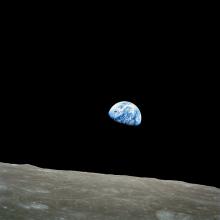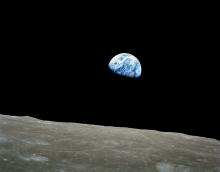Listen to today's episode of StarDate on the web the same day it airs in high-quality streaming audio without any extra ads or announcements. Choose a $8 one-month pass, or listen every day for a year for just $30.
You are here
Morning Mercury
The young solar system was a dangerous place for planets. Several of today’s worlds got blasted by other planets. Earth was hit by a planet as big as Mars, giving birth to the Moon. And Uranus was hit by an even bigger planet, knocking it over on its side.
Mercury probably got hit, too. The Sun’s closest planet is also the smallest. Yet it’s quite heavy. It has a big, dense iron core wrapped in fairly thin layers of rock. That suggests that something big hit the planet when it was quite young, blasting away most of its outer layers.
One problem with that idea is that most models say the debris should fall back onto Mercury within a million years or so. Yet that clearly didn’t happen. And a recent study suggested a possible reason why.
The young Sun was more magnetically active than it is today. That produced a faster, thicker “wind” of charged particles.
If Mercury got hit during the Sun’s first 10 million years, the wind probably blew the debris away from the Sun. In fact, some of that material could have been incorporated into the young Earth. If the impact came a little later, though, then the debris would have been pulled into the Sun. Either way, the young planet was stripped of its outer layers — leaving it small but heavy.
And Mercury is just peeking into view in the dawn sky. It looks like a moderately bright star quite low in the east-northeast as twilight paints the sky. It’s well to the lower left of Venus, the “morning star.”
Script by Damond Benningfield





